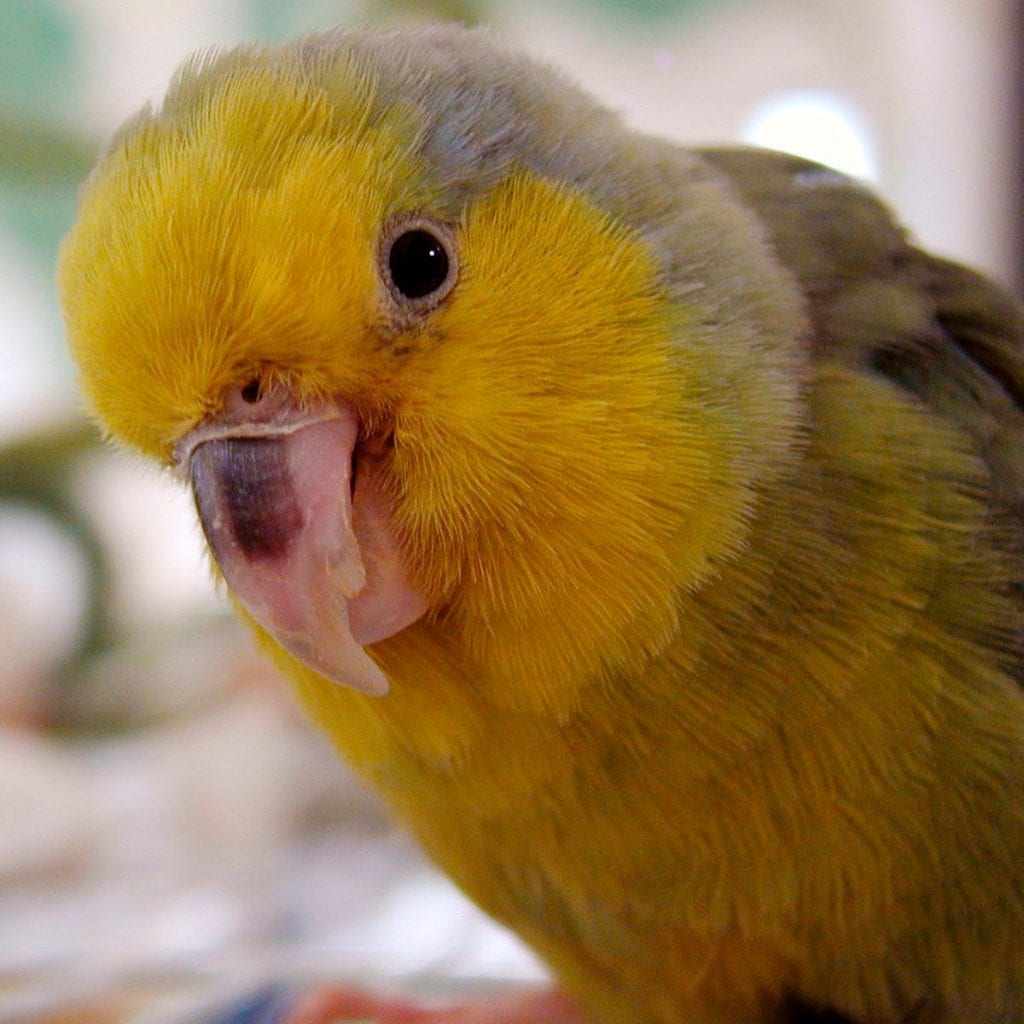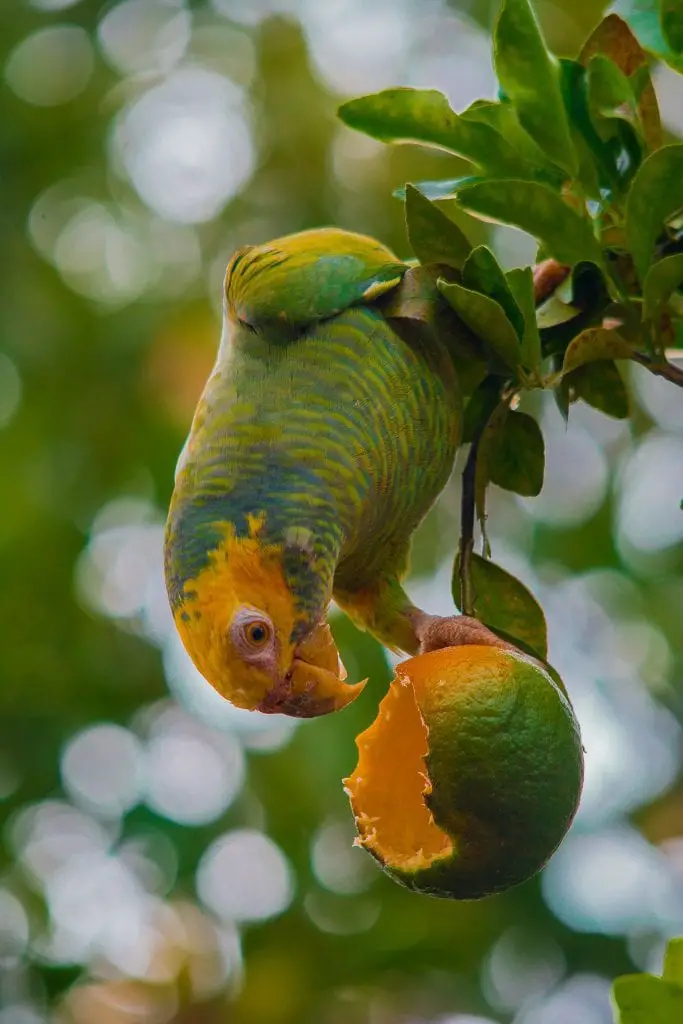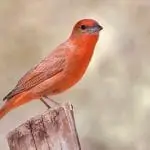Scientific Facts
| Common Name: | Yellow-faced Parrotlet |
| Scientific Name: | Forpus xanthops |
| Life Span: | 10-20 years |
| Size: | 6 inches |
| Habitat: | Woodland, desert scrub |
| Country of Origin: | Mexico |
Physical Appearance

Yellow-faced parrotlets are among the biggest in the family of parrotlets. Nevertheless, they remain tidy. Adult parrotlets have a length of 6 inches and weigh only 45 grams. They have plenty of various colors and distinct combinations deriving to a very beautiful parrot with plenty of specifics to assimilate. The head is mainly brilliant yellow, with the same tint that extends to the chest and slowly converting to green right on the lower abdomen. The backside of the head has a beautiful light blue-grey tint. Their wings, along with the backside, are dark olive green, with the appropriate volume of grey hue. The entire appearance is completed with some dark blue flight feathers and a beak that is horn-colored with a slight black taint at the top.
Lifespan
Yellow-faced parrotlets have an expected lifespan of 10 to 20 years. Nevertheless, the lifespan of parrotlet is always dependent on its kind of environment and whether it receives proper nutrition and sufficient exercise. Despite the longer life expectancy, these creatures won’t be able to survive if they are exposed to an unhealthy environment.
Eating Habits
Yellow-faced parrotlets are herbivores. They normally feed on leaf buds, fruits, berries, blossoms, and nuts. They can also rob on cultured crops. Serve food in open bowls since parrotlets will not put their heads into bowls with cover.

Sleeping Habits
Parrotlets require at least 12 hours of sleep during night-time. However, they are particular in their environment. Make sure that the cage is positioned somewhere that is not breezy or exposed to the light of the sun. Handlers can help their parrotlet get enough sleep by covering its cage during night-time. This will make them relate darkness with time for sleeping.
Development and Reproduction
Yellow-faced parrotlets commonly breed from March to April. The female parrotlets lay clutches averaging 3 to 6 small white eggs and are incubated for around 3 weeks. A maximum of 3 broods is raised every year. In reality, these creatures do not create nests but rather chew and reposition wood shavings into shallow holes on the surface. The young chicks fledge after around 5 to 6 weeks.

How to Breed
Determining the Sexes
Sexing yellow-faced parrotlet can be done by visually checking the physical traits. A male yellow-faced parrotlet has a yellow forehead, throat, cheeks, and crown. The nape and occiput are purple-grey, which stretches in a stripe to the eye. The mantle, higher back, and lesser wing coverts are olive-grey with the same tints that stretches to the scapulars and interior secondary feathers. The rump, lower back, upper tail coverts, and underwing coverts are deep blue. Secondary coverts are purple-blue. Interior primary feathers saturated with blue in the bases. The underparts are green-yellow. Eyes are brown, and the bill is horn-color with a touch of grey at the base of the upper mandible.
Female yellow-faced parrotlet, on the other hand, is almost identical to the male, except that its back is lower, and the rump is duller blue. The primary and secondary coverts, as well as the bases to primary feathers and the secondary feathers, are all green imbued with blue.
Courtship and Mating
In terms of courtship and mating, yellow-faced parrotlets are characterized as monogamous. During the season of breeding, they live in pairs and mate for life.
Eggs and Incubation
Their nests are commonly seen in empty tree cavities. Breeding season runs from March to April. Normally there are 2 to 3 eggs in every clutch. The incubation period takes place for 26 to 28 days. Similar to other parrots, the male parrotlet feeds the female parrotlet through regurgitation while she feeds her chicks or performs the incubation.
Caring for Hatchlings
The chicks abandon the nest once they reach 8 to 12 weeks old. They become mature reproductively after reaching the age of 3 to 4 years.
Common Health Problems
Polyoma Virus
Polyomavirus demonstrates in liver disease, which could to death. A vaccine is available to this kind of virus. If you are not certain about the condition of your bird but you are suspecting it to have a polyomavirus, it would be best if you consult with your vet.
Parrot Fever
Parrot fever can be contagious to men. There is a possibility that your parrotlet is affected with this kind of illness if it demonstrates several symptoms such as difficulty in breathing, sneezing, weepy eyes, and congestion. Parrot fever may also result in liver disease and may affect the bird until it dies. Birds are normally treated with antibiotics once they suffer from parrot fever.
Fungus
Respiratory diseases, such as Aspergillosis is caused by fungus. This kind of fungus is commonly available in the surroundings and should not be a problem for birds with a clean environment. Parrotlets are possibly affected with fungus if they exhibit symptoms of appetite loss, frequent urination and drinking, and extreme breathing difficulty. It may be necessary to do surgery to take out the lesions. Nevertheless, there are available antifungal drugs which are commonly prescribed in combination with complementary care like tube feeding and oxygen.
Virus
Herpes virus, in particular, is the cause of Pacheco Disease. This virus invades the liver and is lethal. Aside from the complementary care, it is unfortunate that there is no current medication yet for this kind of illness. No vaccination is yet formulated for Pacheco Disease.
Feather Plucking
Although the plucking of feathers is not a kind of disease, it can be a serious health issue of parrotlet. The reasons behind the plucking of feathers of parrotlet are so wide. The common factors for feather plucking are nutrition, humidity, trauma, allergies, and a whole host of social and behavioral concerns. If you observe your yellow-faced parrotlet plucking or chewing its feathers, it would be best if you consult it with your trusted veterinarian.
Preventing Illnesses
Securing quality care for your yellow-faced parrotlet can go a long way to prevent illnesses. It is always helpful to feed the bird with a nutritious diet, which is composed of pellets, grains, seeds, nuts, and fresh vegetables and fruits. The water should be kept clean. Secure a full range of lighting. Supplements for vitamins and minerals are also important.
Bring your pet to a trusted veterinarian to do an annual check-up. It would also be wise to learn about the common health problems so you would know what to do in case any of these becomes visible in your bird.
With good care, it is always possible to keep your pet healthy. A trustworthy owner would consider learning more about his pet, particularly its health conditions. A healthy parrotlet is someone happy and well-fed.
Behavior
Yellow-faced parrotlets enjoy snuggling up and lounging in your care and the entire scratches. They are nutty and silly, which will surely make you laugh. They are great talkers and singers. They are characterized to be social and enduring parrots. Taking into consideration the size of yellow-faced parrotlet, owners must make sure that they give it more attention. Other than the clear danger of being crushed, the bird also has a troublesome manner of hiding. It enjoys crawling and exploring into the most secretive nook and opening. The owner has to make sure that his pet won’t get stuck while having fun.
Yellow-faced parrotlet is not that loud, thus making it a perfect pet in your apartment. It does not need huge space and is comparably quiet, which is amazing for limited spaces. Other than the random natural call, which includes tweets and chirps, this bird can also grasp some basic words to imitate. Some reports say that this bird can mime some common sounds like whistles and alarms.
Smart and courageous, these creatures can encounter a lot of afflictions if no one will be supervising them when outside the cage. They are very territorial; thus, there is a tendency that they might infiltrate other animals, particularly other birds – even if the other animal is bigger than them if granted the chance. Although this does not imply that they should be the only pet available in the household, they must be physically isolated from other birds as well as pets for their security. Pet owners should train their parrotlets during an early age not to follow them around.
Yellow-faced parrotlets are typically very dynamic, taking so much time in climbing, swinging, and playing with plenty of toys which their cage should cater to. Leather chew toys, ropes, rings, beads, bells, and ladders are the specific favorites of parrotlets. However, they have very powerful beaks considering that their physical size is small; hence, it is very important to only use safe and durable toys.
Habitat
Enclosure
Knowing that the yellow-faced parrotlets are small in size, this can mean that they do not require a huge room. Other than the free flight, a huge and vast cage will be great.
Toys
Parrotlets require plenty of toys in different types inside their cage. You may put chew toys, bells, and ropes. You may also install swings, rings, and ladders. Since these creatures are gifted with powerful bills, you have to secure toys that are made for conures and cockatiels. These toys must be durable. Prevent using toys with detachable or small parts, string, or wire. Regularly inspect the toys for any traces of worn-outs or loose pieces. Remember that these pets are very inquisitive and busy. They may put themselves into trouble by hurting or ingesting small portions of the toys.
Diet
Even though they are little in size, yellow-faced parrotlets require plenty of healthy foods to incite their energetic lifestyle. Parrotlets have their mix of commercial seed, which is particularly formulated for them. This is going to be the primary diet of the yellow-faced parrotlets. You can also incorporate a lot of fresh vegetables and fruits such as carrots, celery, cabbage, oranges, and apples. Yellow-faced relish on these, particularly if you feed these on them directly with your hands. It would also be great to put a cuttlebone in the cage because it is an essential source of calcium.
How to Care for Yellow-faced Parrotlet
Feed your pet with a balanced diet. If there are leftover fruits or vegetables, remove them within 2 hours to prevent them from crumbling. Freshwater should be given daily. Make sure to replace the water if it gets polluted with food, seeds, or other existing materials.
Where to Get?
If you are planning to get yellow-faced parrotlet for your home, you have to make sure that you get it from a reliable seller. A lot of pet stores sell these creatures. Many breeders also sell them as they are breeding for profit. Do not be impulsive. Ask the seller first about the background and health condition of the bird.
FAQs
Which is better – a male or female yellow-faced parrotlet?
Either a male or female yellow-faced parrotlet can make a good pet. However, if you prefer a pet that learns to talk faster, then you better choose the male one. It is approximated that 80 percent of the male parrotlets can learn to talk, while only 20 percent of the female can engage in talking.
Can I teach them tricks?
Yes. Yellow-faced parrotlets are great entertainers. They can learn tricks. However, the process of teaching may take time. Patience is very important when teaching your pet bird a trick. Your pet is smart and can learn things only; you cannot force them to learn it immediately as they may feel stressed.
I do not have so much time to bond with my pet; what should I do?
Although yellow-faced parrotlets are affectionate and they love bonding with you, these creatures are not hard to please. Toys will keep them busy, and these will eventually make them happy.
Can I let my children play with my parrotlet?
Yes. Yellow-faced parrotlets are very adorable and perfect as pets. Your children are safe to interact with them.


